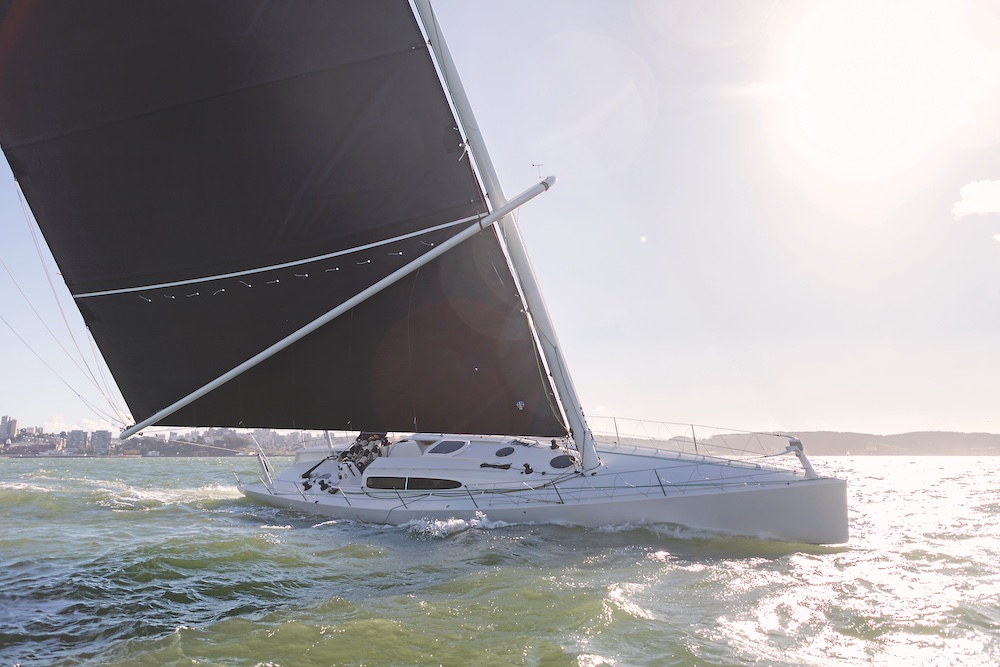
Performance Art — The Creation of ‘C³’
One of the most unique boats to sail the Bay in recent years is Charles Ray’s 60-ft C³ (“C cubed”). Part catboat, part “Batboat,” part performance art, it’s not hard to imagine the Caped Crusader himself might be on the tiller as the boat hisses by.
In fact, C³ is the latest collaboration of two artistic minds: Charles Ray, a world-renowned sculptor, and Bay Area designer Tom Wylie, who has certainly turned out his share of beautiful, functional sailing craft over the years.

Ray grew up in Chicago and learned to sail on Lake Michigan on a Sabot his father bought. On his first solo outing, having no idea what he was doing, “I was hooked,” he says. He was 7.
He came west in the 1970s, settling in the L.A. area, where his modernist sculptures built a wide following in the art world, and where he served for almost 30 years as a professor of sculpture at a well-known university.
Sailing was his other passion, pursued on a series of ever-larger, faster boats. Although he’s sailed and raced with other people, he also likes the peace and serenity of singlehanding, “Where you don’t have to listen to anybody else critiquing what you’re doing,” he laughs. By the early 2000s, Ray was doing a qualifying sail for the Singlehanded Transpacific Race, a biennial event that starts in San Francisco and finishes in Hanalei Bay, Kauai.
All entries are required to do a 400-plus-mile offshore qualifying sail prior to the July start. Ray was about halfway through his qualifier — the long way around several Southern California offshore islands — on the Olson 40 Skimmer, when it and a Navy ship collided around midnight. No one was hurt in the incident, which was later determined to be the Navy’s fault, but the dismasted sailboat was out of commission and Ray didn’t want to spend the time or money to fix it.
It was back to the drawing board in what turned out to be a most literal way. Ray has long been fascinated by the singlehanded sailors who circle the globe on high-end Open 50s and 60s. For him, “rock stars” meant Chay Blyth, Loick Peyron, Ellen MacArthur and other, mostly European skippers. Among the few Americans sailing that rarified air near the turn of the millennium was Northern California’s Bruce Schwab.
He had sailed a unique Open 60 named Ocean Planet around the world in both the Around Alone (2002–2003) and Vendée Globe (2004–2005) races. A feature Ray found particularly intriguing about the boat was its freestanding carbon mast. In his reading, Ray came across a photo showing Schwab standing next to the designer of the boat, a tall, lanky fellow named Tom.
He eventually tracked Wylie down to his East Bay workshop and gave him a call, which turned into many calls, which turned into the all-carbon-fiber 44-ft cat-rigged speedster C² — named for the speed of light in Einstein’s theory of relativity. It sports a cat rig with a freestanding mast and wishbone boom.
“We talked a lot about the rig,” recalls Ray. “Tom had this notion of purity about it, which I understood immediately. Rather than pulling a lot of strings, with the freestanding mast and one big sail, you basically have just the mainsheet and choker (for draft adjustment). With that simplicity, you could spend less time working the boat and more time studying the racecourse, or just enjoying the ride.
“In a way, it brought back the joys of sailing the Sabot all those years ago.”
